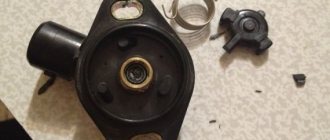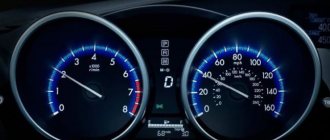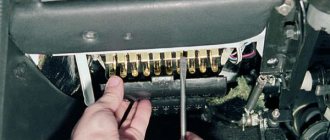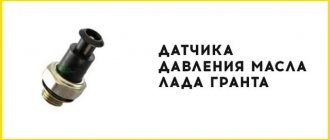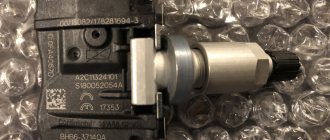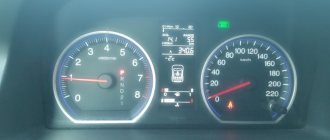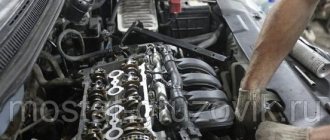Which sensor is responsible for engine speed? List and necessary information
If problems arise with the engine, you may be asked which sensor is responsible for engine speed.
Often it is these electronic devices that drivers are guilty of in the first place. But the sensors should be checked last. The speed can fluctuate for a variety of reasons. First you should make sure there are no other damage. Often problems with speed begin after refueling with low quality fuel.
In this case, the injection system is simply not able to produce a normal mixture.
Where to look for a breakdown?
Which sensor is responsible for engine speed? The answer to this question is both simple and complex at the same time. The reason may be in 4 different sensors:
- Idling speed (IAC);
- Throttle position (TPP);
- Mass air flow (MAF);
- Exhaust gas recirculation (EGR).
Also, in very rare cases, the cause of floating speed may be the crankshaft position sensor. But this happens extremely rarely and we will not consider this option here. Typically, problematic sensors are identified during computer diagnostics. But sometimes it is not possible to visit the service for this procedure. Therefore, you can completely do it yourself to check them.
Idle speed sensor
It should be noted that if it is damaged, the speed will float mainly at idle. But in any case, the check should begin with DXX. To do this, you need to remove the wire block from the sensor. Then the voltage is checked. To do this, one terminal of the wires is connected to ground, that is, applied to the engine. The second wire is connected to the sensor and the voltage is measured.
The multimeter must output a voltage of at least 12V. If the indicator is lower, then the battery may be low. After its charge is restored, engine operation may be restored. You also need to check the resistance at the terminals, it should be 53 ohms. Measurements must be made on paired contacts. You need to change the sensor if the resistance is lower or higher.
Methods for checking DPKV
Before we move on to describing the analysis methods, we will recommend a very simple way out of the situation. Options for checking the speed sensor will not always show a 100% result, displaying only some of the properties of the product. The most practical solution would be if the user borrows a similar synchronization sensor from a friend, installs it, and if the car works without problems, then it is logical that the breakdown is in that one.
Let's look at ways to analyze a crankshaft position sensor from simple to complex. We described the inspection and use of the ODBII scanner above. It must be said that engine speed sensors themselves break down extremely rarely due to the simplicity of their design. Most often, the causes of failure for DPKV are mechanical damage, for example, when the product is touched by tools during car repairs, as well as foreign objects getting between the reference disk and the sensor.
When checking the resistance with a multimeter, you do not need to remove the DPKV. But it will be more convenient to dismantle it. Before removal, mark and remember the original position of the product. To avoid miscalibration, it is important to mark the position with a marker and take a photo with your smartphone. Next, remove the terminal from the car battery and remove the detector - unfasten the controller/power cable, unscrew the fastening bolts.
Analysis of the crankshaft sensor with an ohmmeter
This testing method is used for inductive timing and crankshaft position sensors, that is, for those that have a coil that induces a magnetic environment. Its resistance is measured. You need to switch the multimeter to the mode for measuring the specified value at 200 kOhm; you can similarly use an ohmmeter. The coil contacts (the sensor terminals on its plastic chip, where the controller/power cable is connected) are touched with probes; the polarity does not matter.
The resistance value is specified in the sensor specification (all information is available not only in the paper instructions, but also on the Internet), usually it is in the range of 500–700 or 800–900 Ohms.
The disadvantage of this method is that other parts of the crankshaft detector may be broken, the testing of which is not covered.
Comprehensive test with inductance analysis
The complex method that will be discussed also applies to DPKVs operating on the principle of inductance.
The procedure includes the method described above and a number of other actions, the main of which is inductance analysis.
Procedure:
- Use a multimeter to measure the resistance as described above.
- To measure the inductance of turns, you will need a special device “inductance meter”. The normal value is 200–400 MHz. The analysis can also be carried out with a multimeter, but you will have to buy or make (there are many descriptions on the Internet) a special attachment for it.
- A megohmmeter is used to measure the resistance of the insulating winding between the ends of the detector. At a voltage of 500 V it should not be higher than 20 mOhm.
- Demagnetize the coil or reference disk using a network transformer or another method. If a breakdown occurs after this, the DPKV will need to be replaced.
On throttle position
This sensor is designed for the controller to calculate the throttle opening level. It is installed on the throttle axis. When you press the accelerator pedal, it turns along with the throttle. Essentially, this is a variable resistor that, depending on the angle of rotation, changes the voltage level supplied to the controller.
It is checked this way. The ignition is turned on and the voltage at the sensor terminals is measured. It should fluctuate from 0 V at the starting position, to 12 V at the maximum. You can also measure resistance, but this is not necessary. If the voltage is absent or increases unstably, then the TPS is faulty and needs to be replaced.
Oil pressure sensor - functions, failure
On Japanese cars, a membrane-type oil pressure sensor is installed. The sensor consists of two cavities separated by a flexible membrane. The oil acts on the membrane on one side, bending under pressure. In the measuring cavity of the sensor, the membrane is connected to the rheostat rod.
Depending on the engine oil pressure, the membrane flexes more or less, thereby changing the overall resistance of the sensor. The oil pressure sensor is located on the engine cylinder block.
A burning oil pressure light on the car panel may indicate a sensor failure.
Mass air flow sensor
This sensor controls and normalizes the flow of air into the fuel mixture. Signs of its malfunction are the following problems:
- Unstable speed;
- Problems starting a warm engine;
- Reduced power.
This sensor is checked in different ways. The simplest of them is to turn off the mass air flow sensor and drive without it. If the negative aspects disappear, then most likely the reason is in the sensor. Also, sensor failure can be caused by poor-quality firmware. To do this, place a 1 mm thick plate under the throttle valve stop. At the same time, the speed should increase slightly. Then remove the chip from the sensor we are interested in. If the engine continues to run, the reason is the “crooked” firmware.
The test is also performed by measuring the voltage. To do this, take a multimeter; it should be set to a maximum voltage of 2 V. Next, measure the voltage at the terminals. On a new, fully operational sensor, it should fluctuate between 0.98-1.01 V. A malfunction of the mass air flow sensor is indicated by a voltage of more than 1.05 V. In this case, it should be replaced.
Speed sensor (DS)
The location of the speed sensor is the gearbox housing, and the main task is to record the shaft rotation speed and transmit data to the ECU.
VAZ 2110
The latter, based on the information received, performs calculations and gives commands to other nodes.
So, on cars with manual transmission, the collected information is sent to the speedometer installed on the “dashboard” of the car.
In a car with automatic transmission, in addition to determining the speed itself, a decision is made to change gear.
Additionally, information from the speed sensor allows you to measure distance and display data on the odometer.
The device in question transmits signals in the range of 1-5 Volts to the computer. In this case, the frequency is formed based on the rotation speed of the wheels. The information obtained is used to calculate the speed of movement, and the number of pulses allows you to determine the distance traveled.
The speed sensor is a reliable component, but sometimes it fails, causing the ECU to be unable to make correct decisions regarding speed, distance, and other parameters. The control unit simply does not understand whether the car is stationary or moving.
Failure of the DS can be determined by a number of characteristic signs:
- Speedometer failure or incorrect readings.
- Oscillations XX.
- Increased fuel consumption.
- Reduced power of the power unit, which also affects dynamic performance.
- Quick reaction of the fuel gauge needle to changes in the tank due to the actions of the ECU (the latter believes that the car is stationary, so it smooths out the sensor parameters).
- The car does not respond to pressing the accelerator pedal.
- When driving around the city, the transmission increases the speed significantly, but there is no acceleration. It turns out that the vehicle travels at first speed without engine braking.
- Slow acceleration.
- In some models (for example, Chevrolet) - the engine is turned off and the car cannot be further operated.
The reasons why the speed sensor may fail include:
- Wear and tear of the plastic gear caused by natural aging.
- Oxidation of the contact group due to the lack of protective lubricant or damage to the insulation on the contact group and moisture on them.
- Overheating, which damages the DS body and elements of its internal circuitry. As a rule, under the influence of high temperatures, the capacitor “shorts out” and plays the role of a conductor.
- Damage to wiring due to mechanical stress or excessive heat. Over the years, the wire loses its former elasticity and crumbles, which is especially important in places where it is broken.
- Pickup from another wiring. The reason for the incorrect operation of the speed sensor may be other systems, for example, parking sensors. As a result, the device is exposed to a magnetic field, distorting its operation.
- DC pollution. If the device is of a collapsible type, debris and dirt may get inside. In this case, it may be necessary to disassemble the unit and clean it with WD-40.
- Contact of metal elements on the DS. In devices with a permanent magnet, the malfunction may be caused by the ingress of small metal shavings. As a result, the ECU receives incorrect information and believes that the car is not moving at all.
- Malfunction of the contact group. Often the problem lies in a poor connection between the ECU and the DS. The reason may be damage to the plastic retainer, due to which there is no normal contact.
Before deciding to repair/replace the speed sensor, you need to make sure that it really is not working.
In addition to the signs discussed above, this can be judged by the appearance of error P0500 on the on-board computer about the absence of signals on the DSA. Before starting the test, make sure that the device has 12 V grounding on the contacts.
There are three verification methods:
- Using a voltmeter. To do this, remove the DC, connect the multimeter input to the “pulse” terminal, and the second contact to the motor / car body. Rotate the speed sensor and watch for voltage to appear. The stronger the rotation, the higher this parameter should be.
- No dismantling. To check the vehicle without removing it, place the car on a jack so that one of the wheels does not touch the surface. Next, connect the DC contacts to the multimeter, rotate the wheel and look at the voltage. If it is present, then the device is functioning.
- Using a multimeter. Discard the wire carrying the pulse away from the sensor. Next, turn on the ignition and find the “plus” and “minus”. After hanging the wheel as described above, connect to the signal wire and spin the wheel. If the device lights up “minus”, the DS is functioning. If there is no control device, you can use a lamp.
Be sure to check the DS drive. To do this, lift the car, hang up any of the front wheels and feel for the sensor drive. After this, rotate the wheel and make sure it works.
Auto engine speed sensor
When car enthusiasts have certain problems with the engine, they begin to wonder which sensor is responsible for engine speed, since the first suspicion often falls on these devices.
However, this is not always the case, because the speed can “float” for various reasons. It is best to first make sure that there are no other damage, and check the meters afterwards. One way or another, if you want to locate the sensor you need, you need to know what it looks like and where to look for it.
Coolant temperature sensor
The coolant temperature sensor is actually a semiconductor thermistor. The lower the coolant temperature, the greater the resistance. On the other hand, the lower the resistance, the hotter the antifreeze and, accordingly, the engine itself.
What function does the sensor perform: used to determine the temperature of the coolant in the engine. The electronic engine control unit adjusts the timing of fuel injection and ignition in accordance with the signal received from the coolant temperature. If the coolant temperature exceeds, the electronic system warns the driver of the danger of engine overheating. Thanks also to the sensor, the computer turns on the cooling fan when the coolant temperature begins to rise above the engine operating temperature.
Signs of Trouble: When the coolant temperature sensor fails (usually poor contact, short circuit, open circuit, but in most cases poor contact), a "Check Engine" . The coolant temperature gauge on the dashboard always shows a maximum of 120 degrees Celsius. In this case, the engine power and thrust drop significantly, since the engine control unit must turn on the emergency program (not available in all car models). When scanning for errors using a diagnostic scan tool, the electronic system reads a P003D fault code. Also, if the temperature sensor fails, the car may have difficulty starting when cold. In addition, abnormal fuel consumption may occur.
Basic Concepts
To synchronize the operation of the ignition systems, as well as injection, a speed sensor is provided, or, as it is called, a speed meter. It is he who transmits to the electrical unit that controls the engine the necessary data about what rotations the crankshaft is currently supporting.
This power unit meter is the most important element of the car, without which the interaction of many systems is essential, because it helps ensure the correct functioning of the entire car as a whole.
The car's electronic control unit processes the special signals that this meter sends to find out:
- amount of fuel injected at the moment;
- injection moment;
- time required to activate the adsorber valve;
- ignition timing (for gasoline engines);
- the angle of rotation of the camshaft during operation of the system to change the phases of the gas distribution mechanism.
To determine the performance of the meter, you need to know its location.
Location
The speed sensor, or induction meter, is usually located above the vehicle's marker disc.
The disk, in turn, may be located:
- on the flywheel;
- on the crankshaft inside the cylinder block - this happens with brands Ford, Opel, etc.;
- in front of the engine compartment on the crankshaft, together with the drive pulley for additional units (Jaguar, BMW, VAZ, etc.).
It is best when the marker teeth of the flywheel are intended only for measuring engine speed. It’s a little worse if the starter teeth are marker teeth: this feature is present in Audi and Volvo cars.
A slight curvature of a flywheel tooth or a small chip present on it can often cause a malfunction of the ignition system, due to which the power unit cannot operate at high speeds. In this case, chaotic sparking often occurs because the control unit incorrectly determines the number of teeth.
Signs, symptoms and causes of sensor failure in a car
Good day, dear readers! In the article we will analyze which sensors are responsible for what in diesel and gasoline engines, as well as characteristic signs of their incorrect operation. Remember that before you go to the service station and panic, you should spend a little time and try to find the cause of the malfunction yourself and fix it.
Signs of a malfunction of the TPS sensor
— high speeds are possible at idle, this is the most characteristic sign; — a noticeable decrease in engine power and deterioration in throttle response; — when you press the accelerator, jerks, dips and twitches appear; — floating speed at idle; — when changing gears, the engine stalls spontaneously; — engine overheating is possible; — when accelerating, detonation is observed.
(personally, my symptoms were high speeds, inability to brake with the engine, jerking when releasing the gas pedal, decreased power and, accordingly, increased gasoline consumption).
The photo shows very worn tracks
The reasons for the malfunction of the TPS sensor can be: - oxidation of the contacts, in this situation you need to take a special WD fluid and clean all the contacts in the block and under the cover with a lint-free cloth; — worn-out sensor substrates, if their design included sputtering of a resistive layer, in this situation we take tweezers and carefully, just a little bit, bend the contacts onto entire tracks; — the moving contact fails, some tip of this contact may break, then scoring will form and other tips will also fail; — the throttle valve does not close completely at idle, in this case you can slightly file the sensor seats and the throttle valve should close.
The speed sensor rarely fails
, the average car owner will not be able to diagnose the breakdown, some do not even know where the sensor itself is located, it is located opposite the throttle valve.
The check error does not always appear.
We recommend an article about repairing the TPS; it discusses one of the ways to restore its functionality.
Signs of a malfunctioning idle air valve
— unstable engine speed at idle; — spontaneous increase or decrease in engine speed; — the engine stalls when shifting gears or idling; — no increased speed when starting a cold engine; — reduction in engine idle speed when the load is turned on (headlights, stove, etc.).
The idle control valve will not be able to function normally in this state.
The check error does not always appear.
The best prevention is considered
periodic cleaning of the idle air valve with removal, usually done in the fall and spring. The valve is located near the throttle valve.
Signs of a malfunction of the mass air flow sensor
The MAF sensor can be called a mass air flow sensor, MAP or maf sensor.
Signs of a malfunction of the air flow sensor or absolute pressure in the intake manifold are characterized by: - up to 70 degrees the car works more or less well, after 70 an unstable idle begins; — failures during acceleration and adjustments; — the car sometimes stalls at idle when the gas pedal is sharply pressed; — increased consumption; — unpleasant exhaust smell; — popping noises in the muffler during operation and sometimes popping noises in the intake manifold. (incorrect ignition timing due to faulty sensor).
The air flow sensor is very sensitive and it is not recommended to clean it yourself; the more often you change the filter, the longer it will last you.
The check error only appears when the air flow sensor has stopped working completely, and it can give incorrect readings for a long time.
Check DMRV
or a mass air flow sensor, you can have a multimeter or diagnostic scanner on hand.
Signs of a malfunctioning speed sensor
— the speedometer does not work or gives incorrect readings; — unstable idling; — increased fuel consumption; - the engine stops developing full power. — the fuel gauge needle reacts almost instantly to fluctuations in the fuel level in the tank because the computer thinks that the car is not moving and “smoothes” the sensor readings less; — the odometer does not show mileage; — When changing speed, the automatic transmission resets itself to neutral, or switches spontaneously in an illogical manner; — the car stops responding to the gas pedal and coasts; — in city driving, when picking up speed, the box sharply increases speed and does not accelerate, does not react to other modes 2 and 1. It seems to only drive at speed 1 but does not slow down with the engine.
The principle of operation of the speed sensor on all cars is the same and you can restore it yourself
, let's look at the example of repairing a Nissan Cefiro speed sensor. The speed sensor is located, in most cases, on the automatic transmission side.
Signs and causes of a malfunctioning knock sensor
— It rarely fails. Before the sensor breaks, something is more likely to happen to its wiring. Perhaps something happened to them if, at speeds exceeding 3000, the engine’s sensitivity to how high-quality fuel is poured into it increases. If the fuel turns out to be of poor quality, finger knocking will occur.
knock sensor
- symptoms of incorrect ignition timing. Anyone who has driven a car with a manual engine control system knows what I'm talking about. If you only shift the OZ a few degrees to the early or late side, the engine will either lose its dynamics, as if you were driving with a handbrake, or it will begin to detonate—ringing at light loads or “shooting” into the exhaust system. Everything depends on the detonation resistance of the fuel poured in and the level of pressure at which your engine operates.
For example (from experience), I came across an Audi with a V-engine with two knock sensors, which flatly refused to develop full power. The engine was gaining momentum very sluggishly, and Pavlodar specialists pointed to a clogged fuel system. However, when tested on the bench, the injectors sprayed fuel perfectly, and the pressure gauge showed the reference pressure value in the rail. But still, when measuring the OZ with a strobe, it turned out that it was shifted by more than 10 degrees from the normal value, which is described in the manual. The reason for this was one of the two knock sensors on the second engine block.
Another interesting case involving a faulty knock sensor was with a Subaru engine. When purchased, the car, like the Audi described above, did not develop full power. At the same time, the engine ran very smoothly, the fuel system (injectors, gas tank) was absolutely clean and there were no signs of any malfunctions at all. However, the owner of the car complained that he couldn’t overtake a regular fuel-injected 10-cylinder. Based on our experience with Audi, we checked the knock sensor on this engine, but the sensor turned out to be very “alive”. Resistance is 540 kOhm, as required by the specification. The DD reacted quickly to tapping - 30-40 mV.
The reason was not found soon. On several American sites I found owners of exactly the same cars who also complained about the terrible engine dynamics. But smart Americans quickly realized what was going on and bypassed the knock sensor circuit with a capacitor, and there were those who didn’t really want to tinker with electronics and preferred a pad made of a piece of rubber, which was placed under the sensor. As a result, the sensitivity of the DD was reduced and the appearance of small vibrations in the motor was completely ignored. Thus, after just a few kilometers the car became playful and dynamic.
The check error does not always appear or disappears.
Signs of a malfunctioning coolant temperature sensor
The electronic control system sets the engine temperature suitable for starting to a value of zero degrees Celsius and the corresponding command is sent to the additional air regulator. If the temperature sensor malfunctions, the proportions of air and gasoline in the mixture will be far from optimal, which will make it difficult to start the engine in low temperatures. After the engine manages to start, within two minutes the electronic control unit will decide that the coolant temperature has risen to 80 degrees. For this reason, you will have to use the gas pedal not only when starting, but also when warming up the engine.
coolant sensor
The same malfunction will cause problems in hot weather. When the engine heats up to a temperature whose value is close to the maximum permissible, the control unit will assume that the antifreeze temperature is normal and will not take measures to adjust the ignition timing. There will be a loss of power and engine detonation will occur.
Consider the symptoms briefly: - idle speed is below normal; — incorrect operation of the car fans, they turn on when the engine is cold and do not turn on when required, as a result of which the temperature increases; — the appearance of dark smoke from the exhaust pipe.
Most cars have 2 coolant temperature sensors, data from the first goes to the instrument panel, and the second sensor determines whether the radiator fan is turned on and off.
The error does not always appear.
Answer to the question:
what to do with increased or decreased pulses of the coolant sensor Change, the sooner, the better.
Signs of a malfunctioning camshaft position sensor
— the gearbox is blocked in one gear, usually the first, restarting the engine can solve the problem; — the car moves jerkily; — the car experiences difficulty accelerating after 60 km/h. — the engine stalls periodically, this especially often happens at idle speed; — popping noises in the exhaust gas system are possible; — the spark disappears, the engine cannot be started.
Signs of a malfunctioning crankshaft position sensor
— during intense acceleration, detonation appears; — unstable idle speed; — the car’s speed rises or falls on its own; - the car stalls; — I can’t start the engine.
Signs of a faulty ignition coil
It breaks down quite often.
Symptoms are: - emerging power failures; — reduction in overall engine power; — instability in idle mode; — failures during acceleration, and even shutdown of two cylinders.
If the distance to a service station is several kilometers and you can reach it, you should turn off the corresponding injectors. Otherwise, gasoline injected by injectors into non-working cylinders will wash away the oil. Consequences may vary
from crankcase clogging to sealing rings.
You can check by disconnecting the coils
ignition in turn, when you come across a faulty coil, the engine’s operation will not change.
Signs of a generator malfunction
— when the engine is running, the battery discharge warning lamp flashes (or stays on continuously); — discharge or overcharging (boiling) of the battery; — dim light from car headlights, a rattling or quiet sound signal when the engine is running; — a significant change in the brightness of the headlights with increasing speed. This may be acceptable when increasing the speed (re-throttle) from idle, but the headlights, having lit up brightly, should not increase their brightness any further, remaining at the same intensity; — extraneous sounds (howling, squeaking) emanating from the generator.
Signs of a malfunctioning adsorber
The solenoid valve for purge the adsorber is installed on all modern cars in order to prevent fuel vapors from entering the atmosphere. The adsorber itself is a container filled with an adsorbent that contains fuel vapor. Activated carbon is most often used as an adsorbent.
Signs of a malfunction of the adsorber valve: - a breakdown may cause the purge valve to fail; — a breakdown may cause the fuel pump to fail; — gasoline vapors can accumulate in the intake manifold, as a result the proportion of the air-fuel mixture is disrupted and the engine loses power; - complete engine stop.
Important Features
It should be noted that on some cars the rotation speed sensor replaces the Hall meter: this device can transmit to the main control unit not only a signal about the valve timing, but also engine speed. If this is exactly the situation you have, then you can find the device near the camshaft.
If the crankshaft speed meter fails, you will not be able to start your car: after a thorough check of the ignition and fuel supply system, during which no significant deviations are found, it is recommended to check the performance of the speed sensor.
Oxygen sensor (lambda probe)
This residual oxygen sensor (for example, in the engine exhaust manifold) is used in all modern cars.
What function does the sensor perform: thanks to this sensor, the engine control unit estimates the exact amount of fuel that has not burned in the combustion chamber of the engine block. So, the sensor measures the amount of oxygen in the exhaust gases. Lambda probe readings allow you to prepare the optimal air-fuel mixture, as well as regulate the amount of harmful substances in the vehicle exhaust, reducing the harmful effects of fuel combustion products on humans and the environment.
Signs of trouble: If the oxygen sensor fails, engine performance decreases, the air/fuel mixture is not adjusted, idle becomes unstable, emissions levels in the exhaust system become abnormal, fuel consumption increases, and carbon builds up on the spark plugs. Failure of oxygen sensors is a very common occurrence. Especially in cars that often use leaded gasoline.
If this sensor fails, a “Check Engine” indicator may appear on the dashboard.
see also
How to keep your modern car clean so it can “see” in winter
